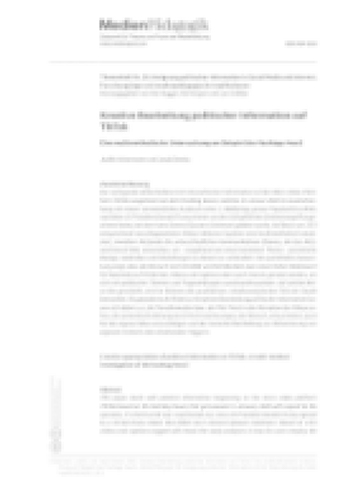Abstract
Social media have become an integral part of formal learning settings. To some extent the possibilities of social media for opening (academic) classrooms are already used. Through this opening of learning spaces new incentives for social exchange arise. But what happens when more and more individuals can partake in the social exchange? Are these new exchange partners perceived? And implies «more exchange partners» greater learning success at the same time? To find answers to these questions, a theoretically derived awareness taxonomy was developed, which was tested in a first setting. The results of the study provide evidence that learners in open learning settings perceive the new exchange partners. The other dimensions of the taxonomy, perspective and group awareness, also contribute significantly to the findings. This article outlines the theoretical derivation of an awareness taxonomy, summarizes the key findings and provides impetus for further studies.References
Allport, Gordon. 1985. «The historical background of social psychology.» In The handbook of social psychology, hrsg v. Gardner Lindzey und Elliot Aronson, 1-46. New York: McGraw-Hill.
Buder, Jürgen. 2011. «Group Awareness Tools for Learning: Current and Future Directions.» Computers in Human Behavior 27 (3): 1114–1117. https://doi.org/10.1016/j.chb.2010.07.012.
Bühner, Markus. 2006. Einführung in die Test- und Fragebogenkonstruktion. Hallbergmoos: Pearson.
Churchill, Gilbert A. Jr. 1979. «A Paradigm for Developing Better Measures of Marketing Constructs». Journal of Marketing Research: 16, (1): 64-73. https://doi.org/10.2307/3150876.
Cress, Ulrike. 2008. «The need for considering multilevel analysis in CSCL research-An appeal for the use of more advanced statistical methods.» International Journal of Computer-Supported Collaborative Learning: 3 (1): 69-84. https://doi.org/10.1007/s11412-007-9032-2.
Deci, Edward L., und Richard M. Ryan. 1985. Intrinsic motivation and self-determination in human behavior. Plenum: New York.
Janssen, Jeroen, Gijsbert Erkens, und Paul A. Kirschner. 2011. «Group Awareness Tools: It’s What You Do with It That Matters.» Computers in Human Behavior 27 (3). Elsevier Ltd: 1046–1058. https://doi.org/10.1016/j.chb.2010.06.002.
Janssen, Jeroen, und Daniel Bodemer. 2013. «Coordinated Computer-Suported Collaborative Learning: Awareness and Awareness Tools.» Educational Psychologist: 48 (1): 40–55. https://doi.org/10.1080/00461520.2012.749153.
Peugh, James L. 2010. «A practical guide to multilevel modeling.» Journal of School Psychology: 48 (1): 85-112. https://doi.org/10.1016/j.jsp.2009.09.002.
Phielix, Chris, Frans J. Prins, Paul A. Kirschner, Gijsbert Erkens, und Jos Jaspers. 2011. «Group Awareness of Social and Cognitive Performance in a CSCL Environment: Effects of a Peer Feedback and Reflection Tool.» Computers in Human Behavior 27 (3). Elsevier Ltd: 1087–1102. https://doi.org/10.1016/j.chb.2010.06.024.
Randall, Dave. 2016. «What Is Common in Accounts of Common Ground?» Computer Supported Cooperative Work (CSCW), 409–423. https://doi.org/10.1007/s10606-016-9256-7.
Renkl, Alexander, und Heinz Mandl. 1995. «Kooperatives Lernen: Die Frage nach dem Notwendigen und dem Ersetzbaren.» Unterrichtswissenschaft 23: 292-301.
Schmidt, Jan-Hinrik. 2011. «Privacy Online.» In Privacy Online. Perspectives on Privacy and Self-Disclosure in the Social Web, herausgegeben von Sabine Trepte und Leonard Reinecke, 159-174. Berlin, Heidelberg: Springer Berlin Heidelberg.
Sheldon, Kennon M. 1996. «The Social Awareness Inventory: Development and Applications.» Personality and Social Psychology Bulletin 22 (6): 620-634. https://doi.org/10.1177/0146167296226007.
Steinert, Anne, Uwe Kern, und Daniel Bodemer. 2015. «Motivated in the global digital Classroom? – Zusammenhänge zwischen “Wahrnehmung Anderer”, Lernmotivation und Kompetenzerwerb.» In DeLFI 2015, herausgegeben von Hans Pongratz & Reinhard Keil, 29-41. Bonn: GI.
Tenenberg, Josh, Wolff-Michael Roth, und David Socha. 2015. «From I-Awareness to We-Awareness in CSCW.» Computer Supported Cooperative Work (CSCW), (c). https://doi.org/10.1007/s10606-014-9215-0.
Vygotsky, Lev. 1978. Mind in society: The development of higher psychological processes. Cambridge: Harvard University Press.
Wegner, Daniel, und Toni Giulliano. 1982.«The forms of social awarenss.» In Personality, roles, and social behavior, herausgegeben von William Ickes und Eric Knowles, 165-198. New York: Springer Verlag.

